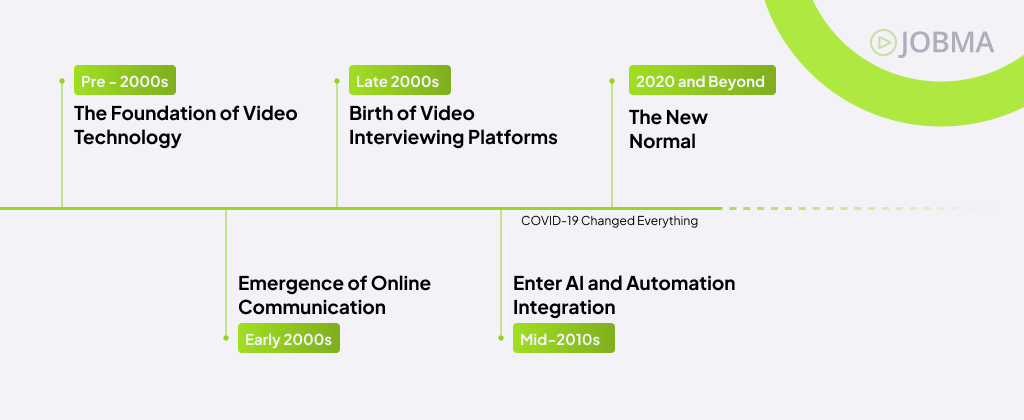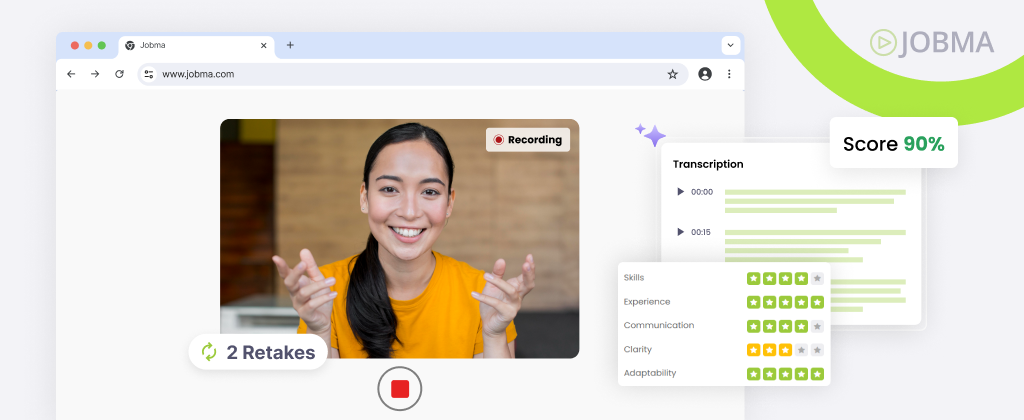The Evolution of Video Interviews: Key Moments That Shaped Virtual Hiring
Video interviewing tools were once used as a backup solution, a convenience to fall back on when in-person meetings weren’t feasible. Fast forward to today, and they’ve become a critical component of global hiring strategies. The global video interviewing software market was valued at $250.06 million in 2022 and is projected to reach $891.86 million by 2030 at a CAGR of 17.2%, reflecting just how far this technology has come.
It may feel like a recent innovation, built for tech-savvy candidates and organizations, but its journey began over 15 years ago. When the idea first emerged, infrastructure was the biggest hurdle. Back then, there was one major problem- webcams weren’t standard on computers, and companies had to ship webcams to candidates just to make remote interviews possible.
Today, video interviews have transformed hiring across industries, long before the pandemic made them mainstream. Among the many digital advancements in recruitment, video interviewing stands out as one of the most transformative, breaking down borders and enabling faster, fairer, and more flexible hiring.

The benefits of asynchronous (or one-way) interviews are now widely known: candidates answer questions on their own time, and recruiters review responses when it suits their schedule. This core value proposition helped early platforms stand out and gain traction. In 2020, a Gartner poll of 334 HR leaders revealed that 86% of organizations began using new virtual interview tech due to the COVID-19 pandemic. But the story didn’t start there.
In this blog, we’ll explore the rise of video interview tools from their early adoption to their explosive growth during the pandemic and their increasingly sophisticated role in future-proofing hiring strategies.
Evolution of Video Interviewing Technology

Pre-2000s: The Foundation of Video Technology
Before the internet era, interviews were either face-to-face or on the phone. Some global companies used VHS recording for remote evaluations (an early form of asynchronous interviewing), especially for C-suite or international hires. Video communication was in its infancy. Long before “Zoom fatigue” existed, early tools like NetMeeting (1996) and CU-SeeMe laid the foundation for video communication. ISDN lines enabled limited video conferencing for enterprises. These early tools planted the seed for what would eventually become remote hiring.
Early 2000s: Emergence of Online Communication
With the improvement in broadband internet and webcam tech, video calls became smoother and more accessible. Skype (2003) became the go-to for international and casual video interviews. Around this time, 42% of companies used video interviews to recruit senior executives, management, and entry-level job functions. Early adopters among recruiters began experimenting with remote evaluations- these efforts weren’t structured yet, but it was a sign of what was to come.
Late 2000s–Early 2010s: Birth of Video Interviewing Platforms
This was the turning point when video interviewing became a product, not just a workaround. Advances in cloud computing and internet infrastructure have led to the rise of dedicated platforms. Companies like HireVue (founded in 2004), Jobma (founded in 2012), and Montage built platforms specifically for hiring, although it was scarce then. One of the earliest use cases was Asynchronous (pre-recorded) interviews.
These platforms introduced features that addressed real hiring needs, pre-recorded interviews, structured questions so recruiters could ask the same questions to multiple candidates, recruiter dashboards, and automated scheduling. They helped recruiters reduce scheduling conflicts, cut travel costs, and streamline early-stage screening, especially for remote or high-volume roles.

Mid-2010s: Enter AI and Automation Integration
By the mid-2010s, video interviewing had moved beyond simple convenience. As the hiring landscape grew more data-driven, platforms began integrating AI and automation to enhance decision-making, reduce time-to-hire, and bring structure to what had traditionally been a subjective process.
Natural Language Processing (NLP) enabled software to assess vocal tone, pace, energy, and specific word usage. This gave hiring managers an additional lens through which to assess communication skills, emotional intelligence, and fit for customer-facing roles. Algorithms began generating instant candidate ratings based on pre-set criteria, such as alignment with company values, job requirements, and previous hiring data. This helped recruiters prioritize high-potential applicants faster and at scale.

However, these advancements also brought challenges. Bias concerns and the “black box” nature of AI systems, where even creators struggle to explain how decisions are made, have raised concerns over fairness and accountability. As a result, privacy laws like GDPR (Europe) and Illinois’ Artificial Intelligence Video Interview Act (U.S.) emerged in response, requiring disclosures, opt-ins, and limits on how biometric and behavioral data could be used.
2020s: COVID-19 Changed Everything
The world shut down in 2020, but hiring didn’t because business continuity depended on it. Companies faced increased attrition, evolving workforce needs, and critical roles still needed to be filled in each sector. The pandemic acted as a major catalyst, remote work went from being optional to necessary, and video interviews became the default for companies of all sizes. In response, organizations rapidly adopted video interviewing tools to maintain hiring continuity, transforming what was once a niche practice into a standard part of the recruitment process across industries.
Enterprises like Unilever adopted structured, pre-recorded interviews to handle mass hiring. Goldman Sachs moved tens of thousands of interviews online. Different video interviewing platforms raced to innovate, introducing data-driven insights, voice and facial analysis, and advanced anti-cheating measures.
Recruiters who once hesitated to adopt this tool now saw video interviewing as essential. What changed?
- Mass adoption across all industries, from startups to Fortune 500s
- Mobile-first design, making it easy for candidates to interview from anywhere
- Live and one-way video formats, integrated with ATS platforms
2020 and Beyond: The New Normal
In the last few years, we’ve seen video interviewing evolve, no longer just about recording responses or hosting virtual calls, it has evolved into a comprehensive talent intelligence ecosystem. Today, such platforms support everything from live coding tests to large-scale screening with AI-powered analytics. Integrated seamlessly into recruitment ecosystems, they offer data-rich insights, reduce unconscious bias, and elevate candidate experience, all while supporting global, remote-first teams.

Platforms now offer real-time transcription and automated interview summaries, they’re now using gamified assessments to evaluate problem-solving, reaction time, and adaptability in a more engaging format. As companies expand globally, platforms are offering real-time language translations, local compliance settings, and inclusive accessibility features like closed captioning and screen-reader compatibility, ensuring every candidate has an equal shot.
Video interviewing has now become a critical tool for enterprise-level hiring used by global brands to assess thousands of candidates efficiently.
Market Growth
The global video interviewing software is projected to grow at a CAGR of 17.2% from 2022 to 2030, reaching $891.86 million by 2030. Approximately 74% of recruiters report that online interviews have made it easier to screen and evaluate candidates. Additionally, 60% of hiring managers use video interviews as part of their recruitment process, marking a 49% increase over the last decade.
Companies adopting these tools are not just using them but optimizing hiring outcomes with video interviews, reducing time-to-hire, and improving candidate satisfaction.
Jobma’s Role in Shaping the Market
Founded with a vision to make hiring simpler and more efficient, Jobma took video interviewing a step further. The platform made it easier for companies of all sizes to adopt video interviewing, offering a global infrastructure, an intuitive design, and seamless integration with existing ATS tools.
Jobma’s focus on the candidate experience sets it apart. With features like branded interviews and multilingual capabilities, it empowers companies to deliver inclusive, personalized, and professional hiring, whether for entry-level roles or executive searches.
As demand grew, so did its capabilities. The platform now supports hiring in over 50 countries, serving 3,000+ customers offering one-way, live, and AI-assisted video interviews, anti-cheating technology, and support for language and skill assessments. It supports 18 languages and is SOC 2 Type II certified, GDPR and CCPA compliant, ensuring your data is protected and safe. It can be seamlessly integrated with leading ATS and other tools in your HR tech stack.
Jobma is also committed to responsible innovation. Its AI features are designed with transparency, fairness, and ethical hiring in mind to help recruiters make data-backed decisions without compromising integrity. In a crowded hiring market, video interviews help teams cut through noise, move faster, and create stronger first impressions. But more than that, they support remote collaboration and global growth.
Jobma’s journey mirrors the journey of video interviews themselves: what started as a workaround has evolved into a powerful hiring engine, one that’s changing how the world works, one interview at a time.
How Video Interviewing Changed the Hiring Process
What began as a convenience has evolved into an essential, helping companies reduce recruitment costs, improve decision-making, and set a new standard for fairness. Here’s how video interviewing has transformed the hiring process:
- Reduced Time-to-Hire: No more calendar battles or back-and-forths. With pre-recorded interviews, recruiters can review responses on their own time, accelerating screening and decision-making. Companies using video interviews reported reducing their time-to-hire by 70% on average.
- Reduced Hiring Cost: Video interviews reduce the time recruiters spend on early-stage screening, lowering the cost-per-hire. It also helps identify better-fit talent fast, minimizing costly mismatches and turnover.
- Expanded Talent Pool: Geography is no longer a barrier. Video interviewing made it possible to evaluate candidates across time zones, enabling truly global hiring without travel costs or delays.
- Improved Candidate Experience: Candidates appreciate flexibility. Asynchronous interviews let them respond when they’re ready, in a familiar environment, often resulting in more authentic responses.
- Data-Driven Evaluation: Video platforms now offer structured scoring, analytics, and feedback tools. Hiring is no longer based on gut feel alone, it’s backed by insights, recorded data, and consistent evaluation methods.
- Fairer & More Consistent Interviews: Every candidate gets the same set of questions, time limits, and experience, helping reduce interviewer bias and increase transparency.
- Better Collaboration Among Hiring Team: With interview recordings, feedback can be shared across departments and locations, allowing multiple stakeholders to weigh in, even if they weren’t present live.
- Candidate Expectations: Gen Z and millennial candidates expect digital-native hiring experiences, and video interviews are fast becoming the default.
- Crisis Resilience: Whether due to pandemics, natural disasters, or geopolitical instability, remote interviews ensure continuity in hiring operations.
Final Thoughts
From early Skype calls to today’s AI-powered screening, video interviewing has come a long way. What started as a workaround for distance has evolved into a recruitment essential, helping companies connect, evaluate, and hire talent more efficiently than ever before.
Whether you’re an early adopter or just getting started, platforms like Jobma are here to simplify the process, elevate your brand, and connect you with the best candidates, wherever they are.




